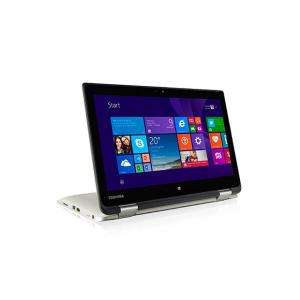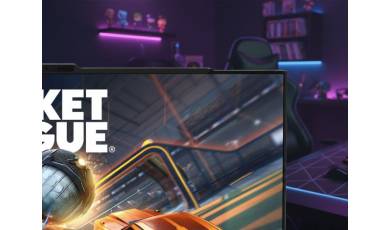Toshiba Satellite Radius L10W-B-101 (PSKVUE-00301DGR) specs.
Laptops Specs >> Toshiba >> Toshiba Satellite Radius L10W-B-101 (PSKVUE-00301DGR)| Specifications | | | Reviews | | | Useful keys |

Processor Toshiba Satellite Radius L10W-B-101 (PSKVUE-00301DGR)
Processor speed:
2.16 GHz
Processor family:
Intel® Celeron®
Processor:
N2840
Processor boost frequency:
2.58 GHz
Processor core:
2
Processor threads:
2
Processor cache:
1 MB
Processor socket:
BGA1170
Processor cache type:
L2
Maximum number of PCI Express lanes:
4
PCI Express slots version:
2.0
PCI Express configurations:
1x4
Thermal Design Power (TDP):
7.5 W
Processor series:
Intel Celeron Processor N2000 series for Mobile
FSB Parity:
No
Tjunction:
100°C
Scenario Design Power (SDP):
4.5 W
Processor codename:
Bay Trail
Processor lithography:
22 nm
Processor operating modes:
32-bit, 64-bit
Stepping:
C0
Conflict Free processor:
Yes
ECC supported by processor:
No
Memory Toshiba Satellite Radius L10W-B-101 (PSKVUE-00301DGR)
Internal memory:
4 GB
Internal memory type:
DDR3L-SDRAM
Memory clock speed:
1600 MHz
Memory layout:
2 x 4 GB
Maximum internal memory:
4 GB
Memory form factor:
On-board
Storage Toshiba Satellite Radius L10W-B-101 (PSKVUE-00301DGR)
Total storage capacity:
500 GB
Storage media:
HDD
Hard drive capacity:
500 GB
Hard disk rotational speed:
5400 RPM
Card reader integrated:
Yes
Compatible memory cards:
MMC, SD, SDHC, SDXC
Display Toshiba Satellite Radius L10W-B-101 (PSKVUE-00301DGR)
Screen Size:
11.6"
Screen Resolution:
1366 x 768 pixels
Touchscreen:
Yes
LED backlight:
Yes
HD type:
Not supported
3D compatibility:
No
Aspect ratio:
16:9
Graphics Toshiba Satellite Radius L10W-B-101 (PSKVUE-00301DGR)
On-board graphics adapter:
Yes
Discrete graphics adapter:
No
On-board graphics adapter family:
Intel HD Graphics
On-board graphics adapter model:
Intel HD Graphics
On-board graphics adapter base frequency:
311 MHz
Number of displays supported (on-board graphics):
2
On-board graphics adapter burst frequency:
792 MHz
On-board graphics adapter dynamic frequency (max):
792 MHz
Discrete graphics adapter model:
Not available
Optical Drive Toshiba Satellite Radius L10W-B-101 (PSKVUE-00301DGR)
Optical drive type:
No
LightScribe:
No
Audio Toshiba Satellite Radius L10W-B-101 (PSKVUE-00301DGR)
Audio system:
DTS
Built-in microphone:
Yes
Camera Toshiba Satellite Radius L10W-B-101 (PSKVUE-00301DGR)
Front camera:
Yes
Rear camera:
No
Swivel webcam:
No
Networking Toshiba Satellite Radius L10W-B-101 (PSKVUE-00301DGR)
Bluetooth: Bluetooth is used to exchange data between nearby mobile devices.
Bluetooth is used to exchange data between nearby mobile devices.
Yes
3G: Third generation cellular network
Third generation cellular network
No
4G: Fourth generation cellular network
Fourth generation cellular network
No
Wi-Fi: Wireless lan technology
Wireless lan technology
Yes
Wi-Fi standards:
802.11b, 802.11g, 802.11n
Wi-Fi data rate (max):
150 Mbit/s
Ethernet LAN connection:
No
Ports & interfaces Toshiba Satellite Radius L10W-B-101 (PSKVUE-00301DGR)
USB 2.0 ports quantity:
1
USB 3.0 (3.1 Gen 1) Type-A ports quantity:
1
HDMI ports quantity: High Definition Multimedia Interface
High Definition Multimedia Interface
1
DVI port: Digital Visual Interface
Digital Visual Interface
No
Headphone outputs:
1
S/PDIF out port: Sony/Philips Digital Interface
Sony/Philips Digital Interface
No
Combo headphone/mic port:
Yes
Docking connector:
No
DC-in jack:
Yes
ExpressCard slot:
No
CardBus PCMCIA slot type: Personal Computer Memory Card International Association
Personal Computer Memory Card International Association
No
SmartCard slot:
No
Ports & interfaces Toshiba Satellite Radius L10W-B-101 (PSKVUE-00301DGR)
Total number of SATA connectors:
2
Performance Toshiba Satellite Radius L10W-B-101 (PSKVUE-00301DGR)
GPS: Global Positioning System
Global Positioning System
No
Gyroscope:
Yes
TV tuner integrated:
No
Keyboard Toshiba Satellite Radius L10W-B-101 (PSKVUE-00301DGR)
Pointing device:
Touchpad
Windows keys:
Yes
Software Toshiba Satellite Radius L10W-B-101 (PSKVUE-00301DGR)
Operating system installed:
Windows 8.1
Operating system architecture:
64-bit
Bundled software:
DTS Sound
TOSHIBA Eco Utility
TOSHIBA Function Key
TOSHIBA Media Player by sMedio TrueLink+
TOSHIBA PC Health Monitor
TOSHIBA System Settings
Toshiba Display Utility
TOSHIBA Eco Utility
TOSHIBA Function Key
TOSHIBA Media Player by sMedio TrueLink+
TOSHIBA PC Health Monitor
TOSHIBA System Settings
Toshiba Display Utility
Trial software:
McAfee LiveSafe, Microsoft Office
Battery Toshiba Satellite Radius L10W-B-101 (PSKVUE-00301DGR)
Battery technology:
Lithium-Ion (Li-Ion)
Number of battery cells:
2
Battery life (max):
5.5 h
Energy Management Toshiba Satellite Radius L10W-B-101 (PSKVUE-00301DGR)
AC adapter input voltage:
100 - 240 V
AC adapter output current:
2.37 A
AC adapter output voltage:
19 V
Security Toshiba Satellite Radius L10W-B-101 (PSKVUE-00301DGR)
Cable lock slot:
Yes
Cable lock slot type:
Kensington
Password protection:
Yes
Password protection:
HDD, Supervisor, User
Weight & Dimensions Toshiba Satellite Radius L10W-B-101 (PSKVUE-00301DGR)
Weight:
2.87 lbs (1,3 kg)
Width:
11.4" (289 mm)
Depth:
7.83" (199 mm)
Height:
0.862" (21,9 mm)
Reviews, Questions about Toshiba Satellite Radius L10W-B-101 (PSKVUE-00301DGR)
Write Review / Ask a question about Toshiba Satellite Radius L10W-B-101 (PSKVUE-00301DGR)





